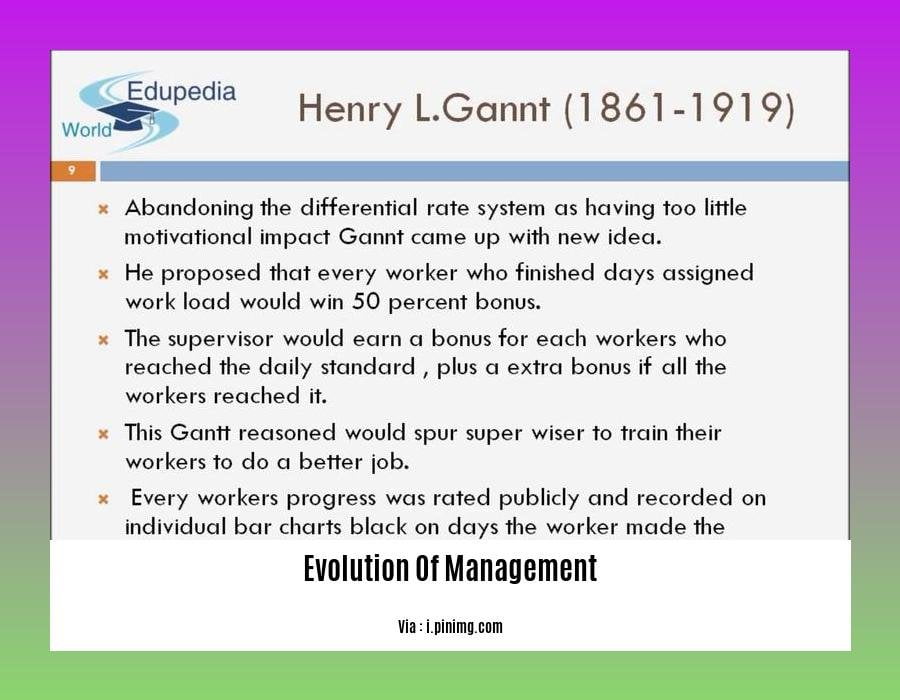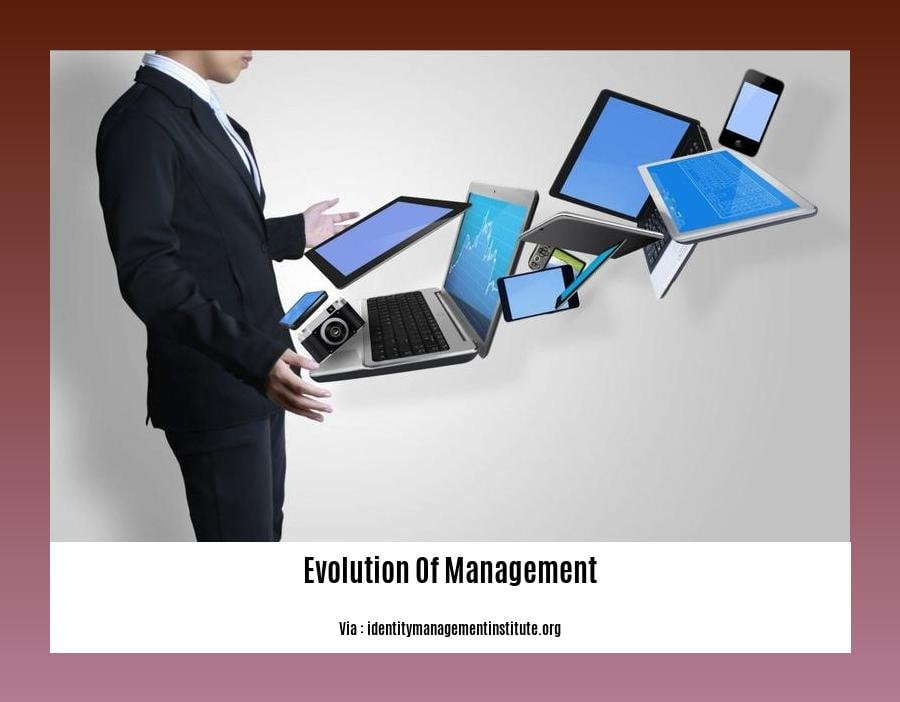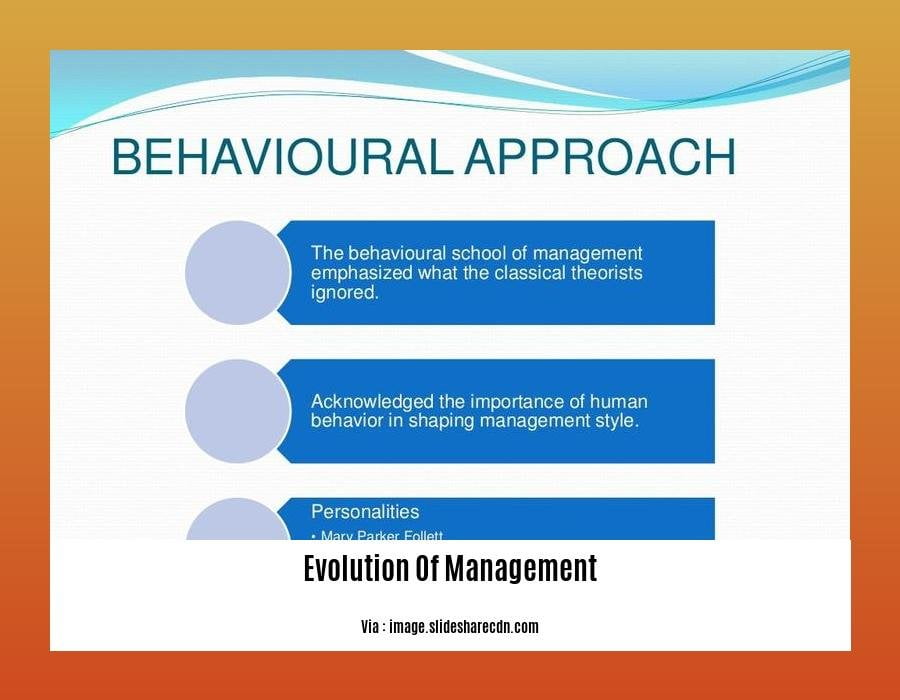Exploring the Evolution of Management Theories: From Classical to Contemporary Approaches
The field of management has undergone a remarkable transformation over the years, shaped by the ever-changing dynamics of the business world and the evolving needs of organizations. From the early classical theories of scientific management and bureaucracy to the more modern and people-focused approaches such as human relations and contingency theories, the journey of management theories has been a fascinating one. In this article, we delve deep into the historical development of management concepts, shedding light on the key milestones that have shaped the way organizations are managed today. Join us as we explore the rich tapestry of management theories and unveil the remarkable evolution that has taken place in this critical discipline.
Key Takeaways:
- The evolution of management is the study of how management theories and practices have changed over time to meet the evolving needs of organizations and society.
- The evolution can be divided into different stages: pre-scientific management, classical theory, neo-classical theory, and modern theory.
- The pre-scientific management period focused on personal skills and experiences of managers and workers, laying the foundation for future management theories.
- The classical theory emphasized efficiency, productivity, and division of labor, using scientific principles to optimize work processes.
- The neo-classical theory introduced the importance of human and social aspects of management, such as motivation, leadership, and communication.
- The modern theory of management recognizes the complex and dynamic nature of organizations and includes concepts like systems thinking, contingency planning, and quality management.
- Vedantu.com provides a comprehensive explanation of the evolution of management thought, while businessmanagmentideas.com offers additional insights on the topic.
Explaining the Evolution of Management Theories

The field of management has undergone a remarkable evolution over the years, adapting to the changing needs and demands of organizations and society. From the early pre-scientific management period to the modern era, management theories have evolved to encompass a wide range of concepts and approaches. In this article, we will explore the key milestones and concepts that shaped the journey of management theories, from classical to contemporary approaches.
The Pre-Scientific Management Period
The pre-scientific management period marked the beginning of the study of management principles. During this era, the focus was primarily on the personal skills and experiences of managers and workers. Intuition, trial-and-error, and common sense were the guiding principles in the absence of systematic management theories. While this period laid the groundwork for future developments, it was clear that more structured approaches were needed to optimize organizational processes.
The Classical Theory of Management
The classical theory of management, which emerged during the late 19th and early 20th centuries, introduced a scientific approach to management. It emphasized scientific principles of efficiency, productivity, and division of labor. Key figures such as Frederick Taylor and Henri Fayol played significant roles in developing this theory.
Frederick Taylor’s scientific management approach focused on optimizing work processes and increasing productivity through scientific methods. His principles included the division of labor, time and motion studies, and the emphasis on training and standardization. Taylor’s work laid the foundation for the efficient management of tasks and resources.
Henri Fayol’s administrative management theory provided a comprehensive framework for managing organizations. Fayol identified the four functions of management – planning, organizing, commanding, and controlling – and identified key principles such as unity of command, scalar chain, and discipline. His work emphasized the importance of managerial roles and hierarchical structure in achieving organizational effectiveness.
The Neo-Classical Theory
The neo-classical theory of management emerged as a response to the limitations of the classical theory. This approach introduced the human and social aspects of management, recognizing the critical role of employees in achieving organizational goals. Elton Mayo and Douglas McGregor were key contributors to this theory.
Elton Mayo’s Hawthorne studies highlighted the significance of the human factor in organizations. His research demonstrated that factors such as motivation, leadership, and communication could significantly impact employee performance and satisfaction. Mayo’s work emphasized the importance of creating a supportive work environment to enhance productivity and employee well-being.
Douglas McGregor’s Theory X and Theory Y addressed the contrasting assumptions about employee motivation. Theory X assumes that employees are inherently lazy and require strict supervision, while Theory Y assumes that employees are intrinsically motivated and seek responsibility. McGregor’s work emphasized the importance of understanding and adapting management practices to the diverse needs and expectations of employees.
The Modern Theory of Management
The modern theory of management reflects the complex and dynamic nature of organizations in the contemporary era. It encompasses various approaches such as systems thinking, contingency planning, and quality management to address the challenges of a rapidly changing business environment.
Systems thinking recognizes organizations as complex systems composed of interrelated elements. It emphasizes the need to understand and manage the interactions between different components, considering the organization as a whole.
Contingency planning acknowledges that no single management approach can be universally applicable. It highlights the importance of adapting management practices to the specific circumstances and challenges faced by organizations.
Quality management emphasizes the continuous improvement of organizational processes and products/services. It includes approaches such as Total Quality Management (TQM) and Six Sigma, which focus on enhancing customer satisfaction and eliminating defects and waste.
Conclusion
In conclusion, the evolution of management theories has been a fascinating journey, driven by the need to optimize organizational processes, enhance employee performance, and adapt to changing business environments. From the classical theories of scientific management and bureaucracy to the more contemporary approaches such as human relations and contingency theories, each stage has contributed valuable insights and concepts to the field of management. By understanding this evolution, organizations can leverage the best practices and concepts from different eras to develop effective and adaptive management strategies.
References:
- Evolution of Management Thought – Vedantu.com
- Management Management Thought – BusinessManagementIdeas.com
The benefits of evolution are truly fascinating. To delve deeper into this topic, check out our article on evolution benefits.
Have you ever wondered about the evolution of horses? Discover the incredible journey of horses through time by exploring our comprehensive guide on the evolution of horse byju.
Management theories have come a long way over the years. If you’re interested in learning about the different theories that have shaped the field of management, click here to explore the evolution of management theories.
Curious about how management has evolved over time? Uncover the fascinating details about the evolution of management in our insightful article on explaining the evolution of management.
Exploring the Shift towards Human Relations Theories and the Importance of Employee Satisfaction

The field of management has undergone a fascinating transformation over the years, adapting to the changing needs of organizations and society. One significant shift that has shaped management practices is the move towards human relations theories and the recognition of the importance of employee satisfaction.
The Rise of Human Relations Theory
The Human Relations Movement emerged as a response to the scientific management approach, which prioritized efficiency and productivity through strict control and standardized processes. This movement, influenced by Elton Mayo and his renowned Hawthorne studies, revolutionized management thinking.
Mayo’s research challenged the belief that physical conditions and monetary incentives were the sole motivators for workers. Instead, his studies revealed that factors such as social interactions, group dynamics, and attention from supervisors greatly influenced employees’ productivity. This revelation highlighted the significance of human factors in the workplace, such as communication, relationships, and job satisfaction.
A Paradigm Shift in Management
The Human Relations Movement emphasized a more personal and people-centric approach to management. It recognized that employees are individuals with unique motivations, emotions, and social dynamics. This shift aimed to improve worker morale, job satisfaction, and overall well-being.
Douglas McGregor’s Theory X and Theory Y were born out of this movement. Theory X assumes that employees are inherently lazy and need constant supervision and control, while Theory Y assumes that employees are self-motivated, responsible, and capable of fulfilling their own potential. These contrasting theories demonstrate the transformation in management thinking, focusing on empowering employees and creating a positive work environment.
Implications for Effective Human Resource Management
The shift towards human relations theories has had several implications for effective human resource management.
Understanding Human Nature: Human relations theories highlight the importance of recognizing the unique needs and motivations of employees. By understanding human behavior and psychology, organizations can better tailor their management practices to create a supportive and engaging work environment.
Valuing Employee Motivation: The Human Relations Movement emphasizes the significance of employee motivation in driving performance. By focusing on intrinsic motivations and creating a sense of purpose and fulfillment, organizations can boost employee satisfaction and productivity.
Recognizing Effective Leadership: Human relations theories recognize the pivotal role of leadership in fostering employee satisfaction. Effective leaders inspire and motivate their teams, providing guidance and support to create a positive work culture.
Acknowledging the Role of Informal Groups: The Human Relations Movement emphasizes the importance of informal groups and social interactions within an organization. Recognizing and leveraging these networks can enhance communication, collaboration, and information sharing among employees.
Promoting Effective Communication: Communication plays a critical role in human relations theories. Open and transparent communication channels foster trust, encourage employee involvement, and contribute to a positive work environment.
Key Takeaways:
- The shift towards human relations theories marked a departure from the scientific management approach, emphasizing the importance of employee satisfaction and well-being.
- Understanding the unique needs and motivations of employees is crucial for effective human resource management.
- Employee motivation plays a significant role in driving performance and productivity.
- Effective leadership is essential for fostering employee satisfaction and creating a positive work culture.
- Informal groups and social interactions within organizations have a significant impact on communication and collaboration.
- Effective communication channels contribute to a positive work environment and facilitate employee involvement.
Sources:
– Business News Daily – “How the Human Relations Movement Changed Management”
– Springer – “Human Relations Theory of Organizations”
Emergence of Contingency Theories and the Need for Adaptability in Management Practices
The evolution of management theories has been a fascinating journey, shaped by changing business landscapes and societal expectations. One significant development in management thinking is the emergence of contingency theories, which recognize the influence of situational factors on organizations. This article explores the reasons behind the rise of contingency theories and highlights the need for adaptability in management practices.
Understanding Contingency Theories
Contingency theories of management, which gained prominence in the 1960s, challenged the notion of a one-size-fits-all approach to leadership. These theories argue that effective leadership styles depend on the specific situation and its contingencies. Situational factors such as the state of the economy, availability of skilled labor, and the organization’s culture can significantly impact the success of management practices.
The influential Fiedler’s contingency theory, for example, focuses on the leader’s interaction style and the situation. It acknowledges the importance of situational factors and emphasizes the need for flexibility and adaptability in leadership. This theory suggests that leaders should adjust their management approach based on the circumstances they face.
The Neglect of Situational Factors in Earlier Management Theories
Contingency theories emerged as a response to the neglect of situational factors in earlier management theories. The classical theories of scientific management and bureaucracy, for instance, focused primarily on increasing efficiency, productivity, and division of labor. These theories ignored the influence of external factors and assumed that a standardized management approach would work in all situations.
However, as organizations became more complex and diverse, it became evident that a rigid management approach was ineffective. Theories like the contingency theory of leadership highlighted the importance of adapting management practices to specific circumstances, challenging the traditional view of management.
The Need for Adaptability in Management Practices
The emergence of contingency theories signifies the need for adaptability in management practices. In today’s dynamic and ever-changing business environment, organizations face a multitude of challenges and uncertainties. To navigate through these complexities successfully, managers must be willing to adapt their strategies and approaches.
Adaptability in management practices allows organizations to respond effectively to different situations and contingencies. It enables leaders to make informed decisions based on the unique circumstances they face. Whether it is responding to changes in the market, addressing employee needs, or managing crises, adaptability is crucial for achieving long-term success.
Moreover, adaptability fosters innovation and creativity within organizations. By embracing change and encouraging new ideas, managers can create an environment that promotes problem-solving and enhances organizational performance. The ability to adapt also enhances organizational resilience, helping organizations withstand challenges and thrive in uncertain times.
Key Takeaways:
- Contingency theories recognize the influence of situational factors on organizations and challenge the idea of a one-size-fits-all management approach.
- Earlier management theories neglected situational factors and focused on standardized approaches.
- The emergence of contingency theories highlights the need for adaptability in management practices.
- Adaptability allows organizations to respond effectively to different situations and contingencies.
- It fosters innovation, creativity, and resilience within organizations.
Sources:
1. Contingency Management Theory – MBANote
2. The Contingency Theory of Leadership: A Focus on Fit – PON – Program on Negotiation at Harvard Law School
Current Trends and Future Directions in Management Theory: Embracing Diversity and Technology
The field of management theory has experienced a fascinating evolution over the years, adapting to the changing needs of organizations and society. From the early days of scientific management and bureaucracy to more contemporary approaches like human relations and contingency theories, management practices have continuously evolved. In today’s rapidly changing business landscape, two key trends are shaping the future direction of management theory: embracing diversity and integrating technology.
Embracing Diversity:
Diversity management and organizational culture have gained significant attention in recent years. As organizations become more global and diverse, it is crucial to understand the impact of diversity on organizational performance. Research has shown that embracing diversity can result in a range of benefits, including increased creativity, innovation, and problem-solving capabilities. Organizations are recognizing the value of diverse perspectives and experiences in driving success.
Studies have explored themes such as the relationship between diversity management and organizational culture, the role of leadership in diversity management, and the legitimacy issue in diversity management research. For example, research has highlighted the importance of integrating organizational culture into diversity management practices. It is essential to create a culture that values diversity and fosters inclusion to maximize the potential benefits.
Leadership also plays a critical role in diversity management. Leaders who are committed to diversity and create inclusive climates can drive successful diversity management efforts. Understanding the impact of leadership and involving managers in diversity initiatives can contribute to positive outcomes.
To enhance the legitimacy and effectiveness of diversity management practices, future research should focus on exploring different starting points, operating ranges, and desired outcomes. This will help align diversity management practices with organizational goals and promote diversity as a strategic advantage.
Integrating Technology:
Another significant trend in management theory is the integration of technology. In the digital age, technology is transforming the way organizations operate and manage their resources. From automation and artificial intelligence to data analytics and virtual collaboration tools, technology is reshaping business processes and decision-making.
By embracing technology, organizations can achieve increased efficiency, productivity, and competitiveness. For example, automation can streamline repetitive tasks, allowing employees to focus on more strategic activities. Data analytics can provide valuable insights for informed decision-making. Virtual collaboration tools can facilitate communication and collaboration in geographically dispersed teams.
However, integrating technology also presents challenges. Organizations need to navigate issues such as data privacy, cybersecurity, and the ethical use of technology. It is crucial to strike a balance between technological advancements and the human aspect of management. Maintaining human connections, fostering employee well-being, and mitigating the negative consequences of technology are essential considerations.
Key Takeaways:
- Embracing diversity is a significant trend in management theory, as organizations recognize the value of diverse perspectives and experiences.
- Understanding the relationship between diversity management and organizational culture is crucial for creating a culture that values and fosters inclusion.
- Leadership plays a critical role in driving successful diversity management efforts, and involving managers in diversity initiatives is important.
- Future research should focus on exploring different starting points, ranges, and outcomes to enhance the legitimacy and effectiveness of diversity management practices.
- Integrating technology is another key trend in management theory, enabling organizations to achieve increased efficiency and competitiveness.
- Technology, such as automation, data analytics, and virtual collaboration tools, is transforming business processes and decision-making.
- It is important to navigate challenges related to technology, such as data privacy, cybersecurity, and the ethical use of technology.
- Striking a balance between technological advancements and the human aspect of management is crucial for fostering employee well-being and maintaining human connections.
Sources:
- Diversity management and organizational culture: Literature review
- Diversity in the Workplace: A Review, Synthesis, and Future Research
FAQ
Q1: What is the evolution of management?
A1: The evolution of management refers to the study of how management theories and practices have changed over time, adapting to the changing needs and challenges of organizations and society.
Q2: What are the stages of the evolution of management?
A2: The stages of the evolution of management include the pre-scientific management period, classical theory, neo-classical theory, and modern theory.
Q3: What is the classical theory of management?
A3: The classical theory of management emphasized scientific principles of efficiency, productivity, and division of labor. It aimed to optimize work processes and increase productivity through scientific methods.
Q4: What is the Human Relations Movement?
A4: The Human Relations Movement is a school of organizational thought that focuses on worker satisfaction, informal workplace organizations, and influencing employee productivity. It represents a shift in management that encouraged a more personal type of management.
Q5: What is the contingency theory of leadership?
A5: The contingency theory of leadership posits that there is no one-size-fits-all approach to leadership and that the most effective leadership style depends on the specific situation. It emphasizes the importance of situational factors and the need for flexibility and adaptability in leadership.
















